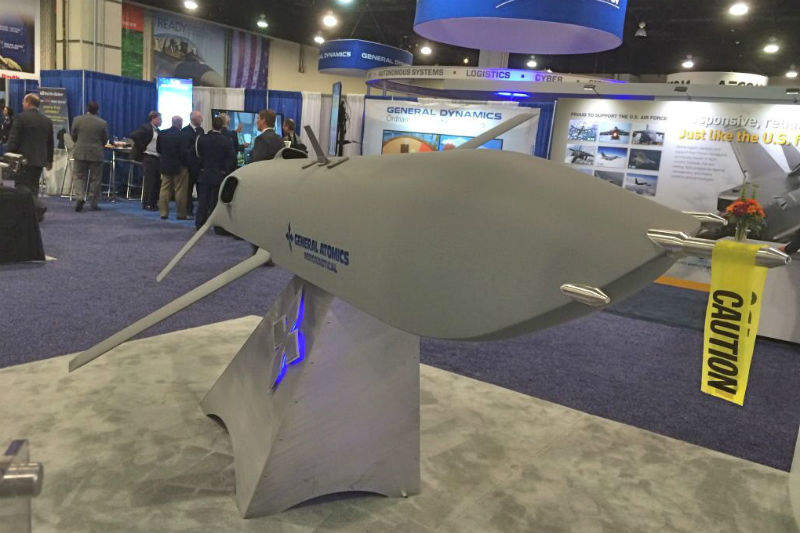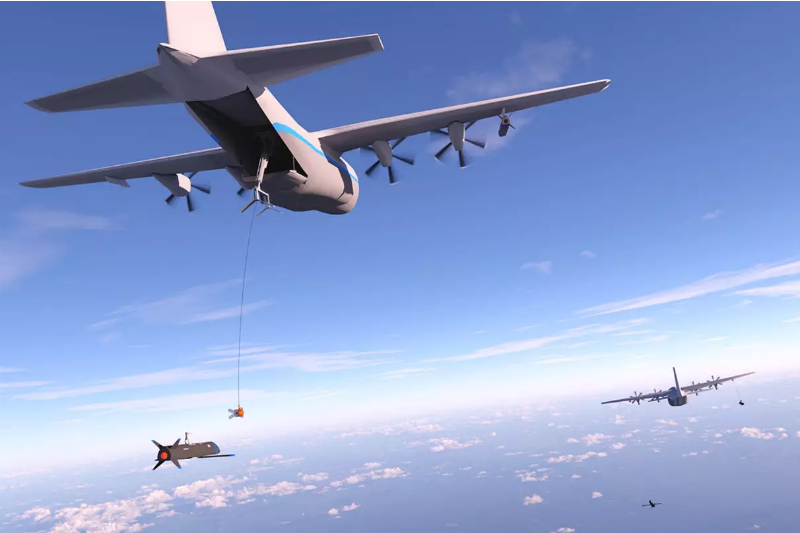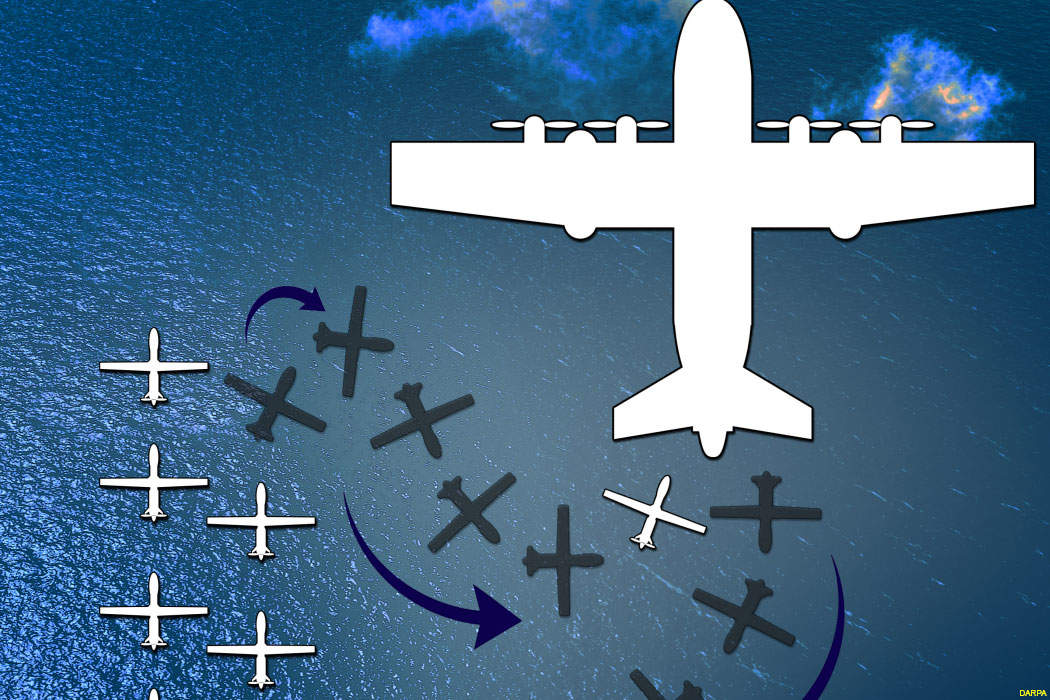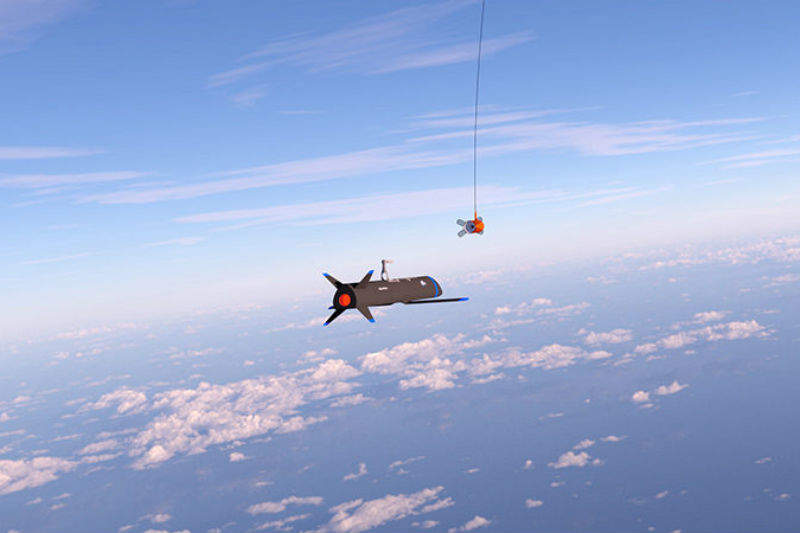The US’s Defense Advanced Research Projects Agency is almost ready to
unleash its Gremlins– a swarm of UAVs built to perform multiple tasks
from intelligence, surveillance and reconnaissance (ISR), to the
delivery of arms and other essential equipment in high risk areas. Talal
Husseini takes a look at the ambitious program.

At roughly a few metres in length, the missile-shaped drones that will make up the US Gremlin UAV Program are built to be lowered from the mothership–a sizeable Lockheed C-130 Hercules transport aircraft–and soon get to work with their intended mission. Once that mission is complete, the C-130 fishes the Gremlins out of the air using a special capture device and carries them home, where ground workers prepare them for their next mission within 24 hours.
That, at least, is the gist of how the US Army’s newest drone ‘swarm’ project is intended to pan out. The Defense Advanced Research Projects Agency (DARPA) has awarded the third and final phase to develop a full-scale technology demonstration of the hard dock and recovery system to a Dynetics-led team of industry partners, including Kratos Unmanned Aerial Systems as the leader of fabrication, assembly, integration, and testing of each UAV. Under Phase III, Kratos will support air vehicle flight tests, recovery tests, system demonstration, as well as planning potential future capabilities.
Scott Wierzbanowski, programme manager in DARPA’s Tactical Technology Office explains: “The programme provides an affordable solution to conduct air combat operations in the growing Anti-Access/Area-Denial (A2AD) environment. Gremlins are small and affordable unmanned vehicles, which means the user has the ability to deploy them in higher risk scenarios that would not be acceptable to manned aircraft.
To better understand what this means in practice, a demonstration was conducted at Yuma Proving Ground in Arizona, US, to provide safe separation and a captive flight test of the hard dock and recovery system, with a special focus on risk reduction via extensive modelling and simulation.
“Early flight tests have given us confidence we can meet our objective to recover four gremlins in 30 minutes,” Wierzbanowski added.
The design involves deploying a towed, stabilised capture device below and away from the C-130 transport aircraft. The Gremlin would dock with the device in similar style to an airborne refuelling operation. Once docked and powered off, the air vehicle is raised to the C-130, where it is mechanically secured and stowed. According to DARPA, this technology can be easily adapted to allow under-wing recovery and bay recovery by other cargo aircraft.
Wierzbanowski says: “The Gremlins air vehicle must take into consideration the position and velocity of the host vehicle, the relative position of the recovery system attached to the host vehicle, and environmental factors such as turbulence. It must then translate all of these variables into guidance control inputs to the air vehicle, which will allow it to make contact with the recovery system.
“While challenging, recent modelling and flight test activities have reduced overall technical risk to an acceptable level. Final flight tests and system demonstrations in 2019 will prove the feasibility of the capability. The swarm coordination technical challenge will continue to be worked through Gremlins and other programs.”
Eric DeMarco, President and CEO of Kratos, said: “Our team is proud to have been successful in this very competitive solicitation with our Prime Partner Dynetics. Kratos is the world leader in high performance jet powered unmanned aerial drone systems, and we are applying this leadership to the Gremlins programme.”
But the idea of a swarm of much more sophisticated and robust drones buzzing around the battlefield performing payload drops and returning intact certainly sounds more complicated. How practical is Gremlins and what are the operational challenges that DARPA will need to address?
First, the cost of keeping a large transport aircraft like the C-130 in the air while the swarm is dispatched is worth bearing in mind. At maximum capacity, the C-130 has a range of 2,356 miles and a maximum fuel capacity of 60,000lb (7,186 gallons). At $5.50 per gallon of fuel, it therefore would cost around $40,000 for the C-130 to stay airborne for its maximum range. The time taken for the C-130 to capture, dock and reel in several drones in quick succession could provide its own issues in a high-intensity conflict situation.
Second, there is a huge amount of computational data that needs to be recorded during the operation of simultaneous drones, with highly trained experts required to conduct analysis and respond quickly. In addition, the growing prominence of electronic warfare highlights the vulnerability of semi-autonomous drones to electronic interference or cyber-attacks, which could effectively render a multimillion-dollar project unusable in a matter of minutes.
For now, the Dynetics-led team will first have to demonstrate beyond doubt that the capturing, refuelling, and hard-docking technologies are fully functional, and that Gremlins is effective in providing speedy assistance to troops on the ground at relatively low cost.

At roughly a few metres in length, the missile-shaped drones that will make up the US Gremlin UAV Program are built to be lowered from the mothership–a sizeable Lockheed C-130 Hercules transport aircraft–and soon get to work with their intended mission. Once that mission is complete, the C-130 fishes the Gremlins out of the air using a special capture device and carries them home, where ground workers prepare them for their next mission within 24 hours.
That, at least, is the gist of how the US Army’s newest drone ‘swarm’ project is intended to pan out. The Defense Advanced Research Projects Agency (DARPA) has awarded the third and final phase to develop a full-scale technology demonstration of the hard dock and recovery system to a Dynetics-led team of industry partners, including Kratos Unmanned Aerial Systems as the leader of fabrication, assembly, integration, and testing of each UAV. Under Phase III, Kratos will support air vehicle flight tests, recovery tests, system demonstration, as well as planning potential future capabilities.
Small and affordable: Gremlins’ role in the growing Anti-Access/Area-Denial environment
Dynetics was awarded the Phase I contract in 2016 to conduct preliminary studies to develop an operational system concept with air recovery capabilities and completed the system design under Phase II last year. The team is also looking to modify the system for other transport aircraft, making the Gremlins an even more attractive prospect. The Phase III contract lasts 21 months, and the award is worth $38.6m. The entire three-phase project is expected to last 43 months and is worth up to $64m in total.Scott Wierzbanowski, programme manager in DARPA’s Tactical Technology Office explains: “The programme provides an affordable solution to conduct air combat operations in the growing Anti-Access/Area-Denial (A2AD) environment. Gremlins are small and affordable unmanned vehicles, which means the user has the ability to deploy them in higher risk scenarios that would not be acceptable to manned aircraft.
"Early flight tests have given us confidence we can meet our objective to recover four gremlins in 30 minutes."
“With the ability to air-recover vehicles, we can use higher cost,
more capable sensors to increase our overall intelligence, surveillance,
and reconnaissance (ISR) capability and do so at a reduced per-mission
cost, well below what either expendable systems or manned aircraft can
provide.”
To better understand what this means in practice, a demonstration was conducted at Yuma Proving Ground in Arizona, US, to provide safe separation and a captive flight test of the hard dock and recovery system, with a special focus on risk reduction via extensive modelling and simulation.
“Early flight tests have given us confidence we can meet our objective to recover four gremlins in 30 minutes,” Wierzbanowski added.
UAVs: A technology of the future
A successful demonstration could see these highly advanced UAVs available as early as next year. Each Gremlin is built to last 20 uses, is cheaper to make than more durable conventional drones, and has both lower emissions and maintenance costs. They can carry up to 150lb of different types of sensor and integrate new technologies to address different types of missions. DARPA is also seeing how the Gremlins can operate in battle scenarios, perhaps in addition to F-35s, F-22s and other combative aircraft.The design involves deploying a towed, stabilised capture device below and away from the C-130 transport aircraft. The Gremlin would dock with the device in similar style to an airborne refuelling operation. Once docked and powered off, the air vehicle is raised to the C-130, where it is mechanically secured and stowed. According to DARPA, this technology can be easily adapted to allow under-wing recovery and bay recovery by other cargo aircraft.
Wierzbanowski says: “The Gremlins air vehicle must take into consideration the position and velocity of the host vehicle, the relative position of the recovery system attached to the host vehicle, and environmental factors such as turbulence. It must then translate all of these variables into guidance control inputs to the air vehicle, which will allow it to make contact with the recovery system.
“While challenging, recent modelling and flight test activities have reduced overall technical risk to an acceptable level. Final flight tests and system demonstrations in 2019 will prove the feasibility of the capability. The swarm coordination technical challenge will continue to be worked through Gremlins and other programs.”
Eric DeMarco, President and CEO of Kratos, said: “Our team is proud to have been successful in this very competitive solicitation with our Prime Partner Dynetics. Kratos is the world leader in high performance jet powered unmanned aerial drone systems, and we are applying this leadership to the Gremlins programme.”
Is Gremlins too ambitious?
Gremlins is not the first UAV project to be carried out by DARPA. In 2015, the agency developed swarms of lightweight, self-destructing UAVs under the Inbound, Controlled, Air-Releasable, Unrecoverable Systems (ICARUS) programme. These propeller-less paper drones, designed by San Francisco R&D firm Otherlab, are guided by an autopilot and a servo; and are capable of delivering 3lb payloads with an accuracy range of ten metres.But the idea of a swarm of much more sophisticated and robust drones buzzing around the battlefield performing payload drops and returning intact certainly sounds more complicated. How practical is Gremlins and what are the operational challenges that DARPA will need to address?
First, the cost of keeping a large transport aircraft like the C-130 in the air while the swarm is dispatched is worth bearing in mind. At maximum capacity, the C-130 has a range of 2,356 miles and a maximum fuel capacity of 60,000lb (7,186 gallons). At $5.50 per gallon of fuel, it therefore would cost around $40,000 for the C-130 to stay airborne for its maximum range. The time taken for the C-130 to capture, dock and reel in several drones in quick succession could provide its own issues in a high-intensity conflict situation.
Second, there is a huge amount of computational data that needs to be recorded during the operation of simultaneous drones, with highly trained experts required to conduct analysis and respond quickly. In addition, the growing prominence of electronic warfare highlights the vulnerability of semi-autonomous drones to electronic interference or cyber-attacks, which could effectively render a multimillion-dollar project unusable in a matter of minutes.
Proving full functionality: Matching ambition to efficiency
The Gremlins programme may be ambitious, but nonetheless represents a big step forward for DARPA’s work into UAV swarms. Gremlins can be useful in high-intensity and in routine operations. Using a single manned aircraft, such as a C-130, to safely and remotely manage multiple UAVs will be essential for enhancing support of tactical strike, reconnaissance/surveillance, and close air support missions.For now, the Dynetics-led team will first have to demonstrate beyond doubt that the capturing, refuelling, and hard-docking technologies are fully functional, and that Gremlins is effective in providing speedy assistance to troops on the ground at relatively low cost.



Δεν υπάρχουν σχόλια:
Δημοσίευση σχολίου